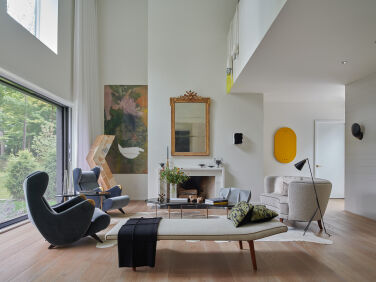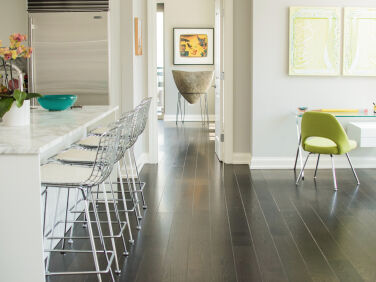Call it the happy medium of home design: where style-forward meets comfortable, considered meets easy. To us, it’s the sweet spot, with interiors that feel cohesive but not too “done.”
One element that can help to achieve that perfect balance? Flooring, which sets the tone for interiors and effortlessly ties together spaces within the home. It’s a designer’s trick to use timeless wood floors to create a traditional but unfussy look. Flooring from Carlisle Wide Plank Floors, for example, mixes artisan craftsmanship, plenty of character, and the organic texture of wood with clean lines and the modern simplicity of wide planks. Their floors are handcrafted, one board at a time. In fact, as many as two dozen pairs of hands will touch each board during the production process. No two floors are alike, and the natural, untouched beauty of the wood creates a design-forward yet trend-proof foundation for any space.

Intrigued? Take a look at these pro tips for mixing clean-lined with classic—and incorporating wide-plank flooring, too—via NYC-based architect Alexander Butler of AB|DS.

1. Mix details with pared-back design.
“Transitional design, to me, is basically a distillation of traditional elements and modern ideas. Details like baseboards, casings, and crown moldings are incorporated; however, these elements are pared down to their most basic level. Clean and simple geometric designs are favored over more grand and decorative gestures.”

2. Keep an open flow.
“I think that the most successful transitional designs incorporate modern ideas, such as symmetry, axis lines, open plans, and gracious circulation, which allows the design to be experienced and appreciated as a whole.”


3. Minimize clutter.
“I typically suggest muted colors and minimal clutter as well in order to clearly delineate transitional versus traditional.”

4. Think traditional materials with a modern twist.
“I love wide-plank flooring. In all of our designs, materiality plays a key role, and in the case of wood flooring, you can’t fully appreciate the character of the material in smaller widths. Also, there are fewer joints, which translates directly into less clutter. Each board is more able to gracefully merge into the next, versus something choppier and more frenetic at a narrower width.”

5. Stick to a serene palette.
For wood floors, Butler says, “I prefer a matte finish in light to medium tones, very similar to my paint color logic: It’s much more soothing to the senses.”

See more via Carlisle Wide Plank Floors.







Have a Question or Comment About This Post?
Join the conversation (0)